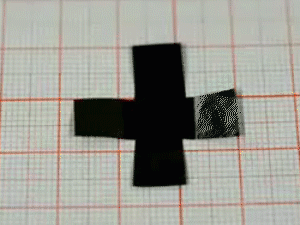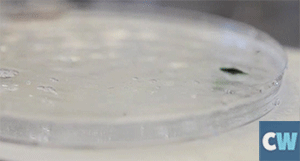Nanoscience – Page 20
-
 Research
ResearchNanodots pencil in way to boost solar cells
Nanoparticles made from pencils’ graphite show interesting optoelectronic properties
-
 Research
ResearchFlat boron first looks promising for nano-electronics
Super hard two-dimensional allotrope has electronic properties that make it a good match for graphene in transistors
-
 Research
ResearchA step forward for graphene walkers
Self-folding paper devices remotely controlled by light show potential as artificial muscles
-
 Research
ResearchUnnatural nanoreactor puts click reaction in the spotlight
Engineered nanopore reveals long-lived ‘click chemistry’ intermediate
-
 Research
ResearchNanotube desalination could be put back on track
Simulations reveal what may have been holding up this promising technology
-
 Research
ResearchStencilling self-propulsion engines
New method prints tiny artificial fish that could find use in water remediation
-
 Research
ResearchUrine recycled into quantum dots
New way of producing carbon dots provides a cheaper and greener alternative to conventional synthesis
-
 Research
ResearchRolled-up electrodes record brain activity without scarring
Super-flexible polymer offers way to monitor neural signals over the long-term for chronic conditions such as Parkinson’s disease
-
 Research
ResearchEnvironmentally-friendly quantum dots make their mark
Indium phosphide nanoparticles offer non-toxic alternative to cadium for richer, more colourful display screens
-
 Research
ResearchCarbon nanotube rectenna directly converts light into electricity
The nanotube array confirms a 40-year old theory and may offer a new way of constructing solar cells
-
 Research
ResearchGraphene band gap heralds new electronics
Higher quality material produces largest band gap ever recorded
-
 Feature
FeatureThe birth of something small
Len Fisher gives a personal account of how colloid science evolved into nanoscience
-
 Research
ResearchGraphene and phosphorene upgrade sodium ion battery
Anodes containing 2D materials boost stability, conductivity and capacity
-
 Research
ResearchTrapped nanoparticles could bring 'wet' computing a step closer
Information can be rapidly stored and retrieved from single colloidal particles using light and electricity
-
 Research
ResearchMolecular Sierpinski triangles get stability upgrade
Another research team have fun with fractals
-
 Research
ResearchBuckyballs prove to be a magnetic proposition for copper
Successful layering of C60 and copper turns the transition metal into a ferromagnet
-
 Research
ResearchNew two-dimensional tin material created
First ever synthesis of stanene will give scientists the opportunity to see if its electronic properties are as odd as predicted
-
 Research
ResearchKirigami graphene makes microscale devices
Ancient Japanese folding and cutting art form used to create functional springs and hinges
-
 Opinion
OpinionDown to business
To make the economic case for research, scientists need to understand how commercialisation works, says Mark Peplow